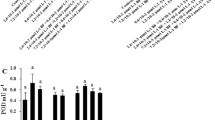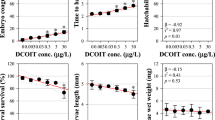Abstract
This study evaluates single and joint endocrine disruptor toxicities of thyroid hormone, levothyroxine, and amiodarone in the embryo-larval stages of Danio rerio. Single toxicity experiments were carried out in concentrations based on the environmental concentration and increasing concentrations of 10, 100, and 1000 times the environmental concentration. Joint toxicity experiments evaluated the combined effects of these compounds. Toxic effects were examined during zebrafish embryonic development, and the parameters analyzed were apical sublethal, teratogenicity, mortality endpoints, and morphometry. Thyroid hormone exhibited the highest toxicity. However, the results showed that the environmental concentrations for all 3 compounds had low risk in relation to the parameters studied, such as teratogenic effects and morphometry. The larvae were more affected than embryos, where embryos needed higher concentrations in all experiments, possibly due to the absence of the chorion. The same type of effects were observed in the joint toxicity test, except that a possible antagonistic effect was detected. However, high concentrations showed stronger effects of these toxic compounds on fish development.




Similar content being viewed by others
Data availability
The data and material used in this study are available from the corresponding author on request.
References
Abdallah MAM (2016) Endocrine disruptors as pollutants in marine ecosystem: a case study in Egypt. Open Biotechnol J 10:131–150
Arbogast P, Flamant F, Godement P, Glösmann M, Peichl L (2016) Thyroid hormone signaling in the mouse retina. PLoS One 11:e0168003. https://doi.org/10.1371/journal.pone.0168003
Bartalena L, Bogazzi F, Chiovato L, Hubalewska-Dydejczyk A, Links TP, Vanderpump M (2018) European ThyroidAssociation (ETA) guidelines for the management of amiodarone-associated thyroid dysfunction Eur Thyroid J 7:55–66. https://doi.org/10.1159/000486957
Cadena PG, Cadena MRS, Sarmah S, Marrs JA(2020a) Folic acid reduces the ethanol-induced morphological and behavioral defects in embryonic and larval zebrafish (Danio rerio) as a model for fetal alcohol spectrum disorder (FASD). Reprod Toxicol 96:249–257. https://doi.org/10.1016/j.reprotox.2020.07.013
Cadena PG, Sales Cadena MR, Sarmah S, Marrs JA (2020b) Protective effects of quercetin, polydatin, and folic acid and their mixtures in a zebrafish (Danio rerio) fetal alcohol spectrum disorder model. Neurotoxicol Teratol 82:106928. https://doi.org/10.1016/j.ntt.2020.106928
Cassar S, Adatto I, Freeman JL, Gamse JT, Iturria I, Lawrence C, Muriana A, Peterson RT, Van Cruchten S, Zon LI (2020) Use of zebrafish in drug discovery toxicology. Chem Res Toxicol 33:95–118. https://doi.org/10.1021/acs.chemrestox.9b00335
Chen Y-H, Lee H-C, Hsu R-J, Chen T-Y, Huang Y-K, Lo H-C, Hu S-C, Harn H-J, Jeng J-R, Sun C-K, Lin S-Z, Tsai H-J (2012) The toxic effect of Amiodarone on valve formation in the developing heart of zebrafish embryos. Reprod Toxicol 33:233–244. https://doi.org/10.1016/j.reprotox.2011.12.008
Colucci P, Yue CS, Ducharme M, Benvenga S (2013) A review of the pharmacokinetics of levothyroxine for the treatment of hypothyroidism. Eur Endocrinol 9:40–47. https://doi.org/10.17925/ee.2013.09.01.40
Elnaggar MN, Jbeili K, Nik-Hussin N, Kozhippally M, Pappachan JM (2018) Amiodarone-induced thyroid dysfunction: a clinical update. Exp Clin Endocrinol Diabetes 126:333–341
Fick J, Lindberg RH, Tysklind M, Larsson DGJ (2010) Predicted critical environmental concentrations for 500 pharmaceuticals. Regul Toxicol Pharmacol 58:516–523. https://doi.org/10.1016/j.yrtph.2010.08.025
Grais IM, Sowers JR (2014) Thyroid and the heart. Am J Med 127:691–698. https://doi.org/10.1016/j.amjmed.2014.03.009
Huttner IG, Trivedi G, Jacoby A, Mann SA, Vandenberg JI, Fatkin D (2013) A transgenic zebrafish model of a human cardiac sodium channel mutation exhibits bradycardia, conduction-system abnormalities and early death. J Mol Cell Cardiol 61:123–132. https://doi.org/10.1016/j.yjmcc.2013.06.005
Jomaa B, Hermsen SA, Kessels MY, van den Berg JH, Peijnenburg AA, Aarts JM, Piersma AH, Rietjens IM (2014) Developmental toxicity of thyroid-active compounds in a zebrafish embryotoxicity test. ALTEX 31:303–317. https://doi.org/10.14573/altex.1402011
Kim K-T, Tanguay RL (2014) The role of chorion on toxicity of silver nanoparticles in the embryonic zebrafish assay. Environ Anal Health Toxicol 29:e2014021–2014020. https://doi.org/10.5620/eht.e2014021
Kinoshita S, Hayashi T, Wada K, Yamato M, Kuwahara T, Anzai T, Fujimoto M, Hosomi K, Takada M (2016) Risk factors for amiodarone-induced thyroid dysfunction in Japan. J Arrhythmia 32:474–480. https://doi.org/10.1016/j.joa.2016.03.008
Kumar A, Shanthi M, Parameswari R (2013) The effect of L-thyroxine on metabolic parameters in newly diagnosed primary hypothyroidism. Clin Exp Pharmacol 3:1–4
Lammer E, Carr GJ, Wendler K, Rawlings JM, Belanger SE, Braunbeck T (2009) Is the fish embryo toxicity test (FET) with the zebrafish (Danio rerio) a potential alternative for the fish acute toxicity test? Comp Biochem Physiol Part C: Toxicol Pharmacol 149:196–209. https://doi.org/10.1016/j.cbpc.2008.11.006
Latini R, Tognoni G, Kates RE (1984) Clinical pharmacokinetics of amiodarone. Clin Pharmacokinet 9:136–156. https://doi.org/10.2165/00003088-198409020-00002
Lee H-C, Lo H-C, Lo D-M, Su M-Y, Hu J-R, Wu C-C, Chang S-N, Dai M-S, Tsai CT, Tsai H-J (2015) Amiodarone induces overexpression of similar to Versican b to repress the EGFR/Gsk3b/Snail signaling axis during cardiac valve formation of zebrafish embryos. PLOS One 10:e0144751. https://doi.org/10.1371/journal.pone.0144751
Lin M-H, Chou H-C, Chen Y-F, Liu W, Lee C-C, Liu LY-M, Chuang Y-J (2018) Development of a rapid and economic in vivo electrocardiogram platform for cardiovascular drug assay and electrophysiology research in adult zebrafish. Sci Rep 8:15986. https://doi.org/10.1038/s41598-018-33577-7
Liu Y-W, Chan W-K (2002) Thyroid hormones are important for embryonic to larval transitory phase in zebrafish. Differentiation 70:36–45. https://doi.org/10.1046/j.1432-0436.2002.700104.x
Marelli F, Carra S, Agostini M, Cotelli F, Peeters R, Chatterjee K, Persani L (2016) Patterns of thyroid hormone receptor expression in zebrafish and generation of a novel model of resistance to thyroid hormone action. Mol Cell Endocrinol 424:102–117. https://doi.org/10.1016/j.mce.2016.01.020
Marelli F & Persani L (2017) How zebrafish research has helped in understanding thyroid diseases [version 1; peer review: 2 approved]. F1000Research 6. https://doi.org/10.12688/f1000research.12142.1
Odum J (2015) Disrupters of thyroid hormone action and synthesis: Endocrine disruption and human health (ed. Elsevier, pp. 91-109)
OECD (2013) Education at a glance 2013: OECD indicators: OECD Publishing.
Overturf MD, Overturf CL, Baxter D, Hala DN, Constantine L, Venables B, Huggett DB (2012) Early life-stage toxicity of eight pharmaceuticals to the fathead minnow, pimephales promelas. Arch Environ Contam Toxicol 62:455–464. https://doi.org/10.1007/s00244-011-9723-6
Pandya M, Patel D, Rana J, Patel M, Khan N (2016) Hepatotoxicity by acetaminophen and amiodarone in zebrafish embryos. J Young Pharm 8:50
Santos TP, Soares PRL, da Silva MCG, da Silva S, de Andrade ALC, Dos Santos AR, da Silva JF, da Silva Oliveira EG, da Silva Souza EHL, de Sa FB, Cadena MRS, Cadena PG (2019) Thyroxine, levothyroxine, and thyroxine complexed into cyclodextrin changed animal behavior, oxygen consumption, and photopic electroretinogram of Colossoma macropomum. Fish Physiol Biochem 45:1177–1187. https://doi.org/10.1007/s10695-019-00630-9
Silva MCGD, Silva JFD, Santos TP, Silva N, Santos ARD, Andrade ALC, Souza EHLDS, Sales Cadena MR, Sa FB, Silva Jr VAD, Cadena PG (2019) The complexation of steroid hormones into cyclodextrin alters the toxic effects on the biological parameters of zebrafish (Danio rerio). Chemosphere 214:330–340. https://doi.org/10.1016/j.chemosphere.2018.09.116
Skelin M, Lucijanić T, Amidžić Klarić D, Rešić A, Bakula M, Liberati-Čizmek A-M, Gharib H, Rahelić D (2017) Factors affecting gastrointestinal absorption of levothyroxine: a review. Clin Ther 39:378–403. https://doi.org/10.1016/j.clinthera.2017.01.005
Spaan K, Haigis A-C, Weiss J, Legradi J (2019) Effects of 25 thyroid hormone disruptors on zebrafish embryos: a literature review of potential biomarkers. Sci Tot Environ 656:1238–1249. https://doi.org/10.1016/j.scitotenv.2018.11.071
Stinckens E, Vergauwen L, Schroeder AL, Maho W, Blackwell BR, Witters H, Blust R, Ankley GT, Covaci A, Villeneuve DL, Knapen D (2016) Impaired anterior swim bladder inflation following exposure to the thyroid peroxidase inhibitor 2-mercaptobenzothiazole part II: Zebrafish. Aquat Toxicol 173:204–217. https://doi.org/10.1016/j.aquatox.2015.12.023
Svanfelt J, Eriksson J, Kronberg L (2010) Analysis of thyroid hormones in raw and treated waste water. J Chromatogr A 1217:6469–6474. https://doi.org/10.1016/j.chroma.2010.08.032
Wang Y, Lv L, Yu Y, Yang G, Xu Z, Wang Q, Cai L (2017) Single and joint toxic effects of five selected pesticides on the early life stages of zebrafish (Denio rerio). Chemosphere 170:61–67. https://doi.org/10.1016/j.chemosphere.2016.12.025
Wen D, Liu A, Chen F, Yang J, Dai R (2012) Validation of visualized transgenic zebrafish as a high throughput model to assay bradycardia related cardio toxicity risk candidates. J Appl Toxicol 32:834–842. https://doi.org/10.1002/jat.2755
Yu L, Chen M, Liu Y, Gui W, Zhu G (2013) Thyroid endocrine disruption in zebrafish larvae following exposure to hexaconazole and tebuconazole. Aquat Toxicol 138-139:35–42. https://doi.org/10.1016/j.aquatox.2013.04.001
Acknowledgements
The authors would like to thank the Universidade Federal Rural de Pernambuco. The authors also thank James Marrs at IUPUI to help in the preparation of the manuscript.
Funding
The authors would like to thank the Universidade Federal Rural de Pernambuco, Coordenação de Aperfeiçoamento de Pessoal de Nível Superior – CAPES to the scholarship to TPS and fellowship for PGC (PRInt #88887.364263/2019-00), Conselho Nacional de Desenvolvimento Científico e Tecnológico – CNPq for the scholarship to PES. Bastos and productivity grant to PGC (Grant 310401/2017-8), Fundação de Amparo à Ciência e Tecnologia de Pernambuco – FACEPE (Grant APQ-0933-2.08/15) and Pró-Reitoria de Pesquisa e Pós-Graduação of UFRPE – PRPPG (Grant PRPPG 05/2018) for financial support.
Author information
Authors and Affiliations
Contributions
Conceptualization, methodology, validation, formal analysis, Investigation, data curation, writing—original draft, writing—review and editing, visualization were performed by TPS. Investigation and data Curation also were performed by PEdSB. SMdMV, MCGdS, RMOP and ARdSM performed investigation. JFdS and ALCdA performed investigation and formal analysis. Co-supervision, project administration, writing—original draft, writing—review & editing were performed by MRSC. Conceptualization, methodology, validation, formal analysis, resources, data curation, writing—original draft, writing—review, and editing, visualization, supervision, project administration, funding acquisition were performed by PGC. All authors read and approved the final manuscript.
Corresponding author
Ethics declarations
Conflict of interest
The authors declare no competing interests.
Ethics approval
The protocols used in this study were approved by the Ethics Committee in the use of animals of the Universidade Federal Rural de Pernambuco - Brazil, protocol number 091/2018.
Rights and permissions
Springer Nature or its licensor (e.g. a society or other partner) holds exclusive rights to this article under a publishing agreement with the author(s) or other rightsholder(s); author self-archiving of the accepted manuscript version of this article is solely governed by the terms of such publishing agreement and applicable law.
About this article
Cite this article
Santos, T.P., da Silva Bastos, P.E., da Silva, J.F. et al. Single and joint toxic effects of thyroid hormone, levothyroxine, and amiodarone on embryo-larval stages of zebrafish (Danio rerio). Ecotoxicology 32, 525–535 (2023). https://doi.org/10.1007/s10646-023-02655-6
Accepted:
Published:
Issue Date:
DOI: https://doi.org/10.1007/s10646-023-02655-6




